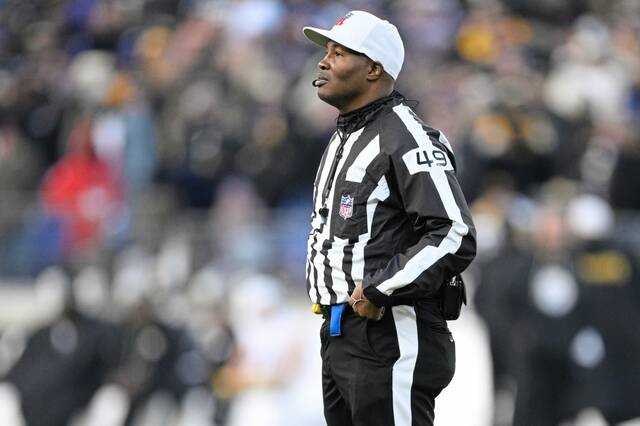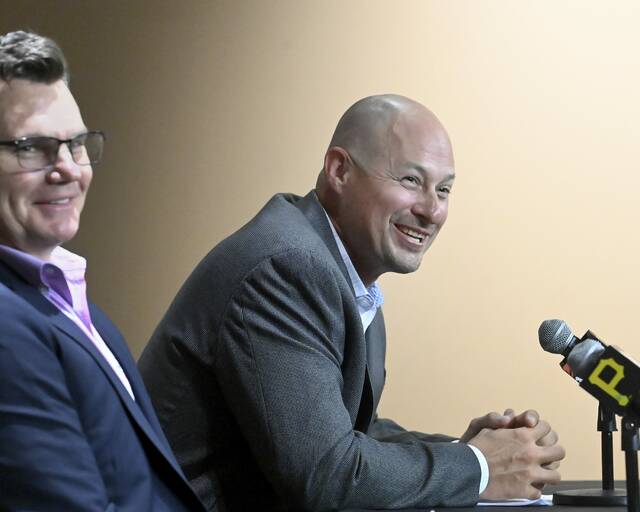As a 33-year-old catcher in his ninth season in the major leagues who enjoyed the time-honored tradition of flashing fingers to signal pitch calls, Roberto Perez was skeptical about the introduction of pitch-calling technology.
Wearing a push-button transmitter on the inside of his left forearm to call pitches was a foreign concept to the Pittsburgh Pirates backstop, who worried it would reduce him to nothing more than a receiver.
“I’m old school. I came up when guys gave signs,” Perez said. “To be honest, at first I didn’t like it because I thought I wasn’t involved in the game. I felt like a computer was just calling the game.”
MLB’s use of PitchCom this season has been well-received by the Pirates through the first two weeks of the regular season, with early evidence showing signs it will speed up the tempo of the game and deter sign-stealing. Both have become major issues in baseball since the sign-stealing scandals involving the World Series champion Houston Astros in 2017 and Boston Red Sox in 2018. Pace of play slowed to a record 3 hours, 10 minutes and 7 seconds last year, as teams were paranoid about protecting their signs.
ProMystic, which designs the wearable technology, approached MLB in 2020 about using PitchCom. It was used on an experimental level in Single-A last season and in spring training before being approved by the MLB Players Association shortly before the season opener.
“I knew it was coming after that scandal in 2017,” Perez said. “Something had to happen. At first, I was worried about what would happen and how’s that going to work. You start wondering because I’ve been giving signs my whole life. But so far, I love it.”
Wondering how PitchCom works?
Harold & @Plesac19 walk you through it in Studio 42. #MLBTonight pic.twitter.com/jwp000Wpkf
— MLB Network (@MLBNetwork) April 9, 2022
This is how PitchCom works: Catchers wear the transmitter, which has buttons in the shape of the quadrants of the strike zone, on their forearms or shin guards. Once the pitch call is sent, the pitcher and three position players — typically, the second baseman, shortstop and center fielder — all receive the call through a speaker lined inside their hats. The voice tells them the pitch type and location — four-seam fastball low and outside, for example — and allows the fielders to anticipate the play.
“It’s not like Siri or Alexa or anything, but it’s a computer-generated voice,” Pirates reliever Chris Stratton said. “In spring training, it was a little weird. I wondered if you could change it to a British accent or something like that. Now it’s pretty normal.”
Pirates broadcast gives us a look at how PitchCom works #stlcards pic.twitter.com/oSuqxIEMiy
— VHS (@VanHicklestein) April 9, 2022
The receiver can be adjusted for a player’s native language, as well as for volume. During Opening Day introductions at Busch Stadium in St. Louis, Pirates starter JT Brubaker said he tinkered with the volume to account for loudness based on the crowd cheers. The volume remains a concern for pitchers and catchers alike. If too loud, Stratton wondered whether the hitter could hear the call. Perez and backup catcher Andrew Knapp said they try to be secretive about sending signals, with Knapp likening it to sending text messages under the desk in class.
“I think it’s sped up the game,” Perez said. “The pitcher gets a better tempo. I don’t have to wait until the batter gets in the box to press what I want. Right after he delivers the pitch, I can call the next pitch.”
The pitch-calling technology is designed to take sign-stealing out of the equation, especially with a runner on second base. That’s why the Pirates started the season by mixing the flash of finger signs when the bases were empty and using PitchCom with a runner at second.
“It does take a little stress out of guys at second base,” Knapp said. “You’re going through five, six different sign sets to get to a pitch. Now you just click it and it’s either a shake or a ‘Let’s go.’ That part definitely helps. I’ve been on teams where you know the other team definitely has your signs. It’s not fun. For me, it’s a lot less stressful.”
Both Pirates manager Derek Shelton and Brubaker credited the full-time use of PitchCom for setting the quick pace (2 hours, 29 minutes) Tuesday night at the Milwaukee Brewers. Through the Pirates’ first dozen games this season, five have been played in less than three hours, including the past three.
“It’s so easy to get the pitch and go because it’s right in your ear,” Brubaker said, “instead of waiting for your mechanical delivery.”
Pirates middle infielders Kevin Newman and Diego Castillo have found it allows them to anticipate the direction of not only the pitch but to get a good jump when contact is made.
“Knowing what pitch is coming is nice,” Newman said. “Before, it was a lot more difficult. I had to know all the signs, all the rotations of signs, lock in on every pitch. Now it’s just a computer saying it in your ear.”
While players privately expressed concerns that it’s become so easy both pitchers and fielders could unwittingly tip a pitch based on the placement of their glove or footwork or by shifting too far in anticipation, Shelton isn’t worried about that happening with the Pirates.
“Not really, because middle infielders should be watching pitches anyway,” Shelton said. “They should know what’s coming because they know the sequence of signs. Even when we had a sequence in the hats, they knew where we were at and what was going on. As much movement that there is right now with shifts, it doesn’t concern me.”
Another potential benefit is PitchCom could help protect catchers by reducing or eliminating pitch call cross-ups, as confusion can lead to wild pitches and, even worse, injuries.
“That’s the big thing for me,” Stratton said. “I don’t want to cross-up our catcher with signs. Maybe they are too complicated, with the constant switching. You just want them to be healthy. You already worry about foul tips and crossfires and all of that stuff.”
While PitchCom is still in the introductory stage, it’s quickly converting catchers such as Perez from doubters to believers who expect it to have a positive impact on making games go faster and reduce the cheating.
“I think it’s a game changer,” Perez said. “You’re going to see a lot of guys have success because they don’t have to worry about signs. Their tempo is going to be there. Guys don’t have to worry about stealing signs. They can just focus on executing the pitch.”















